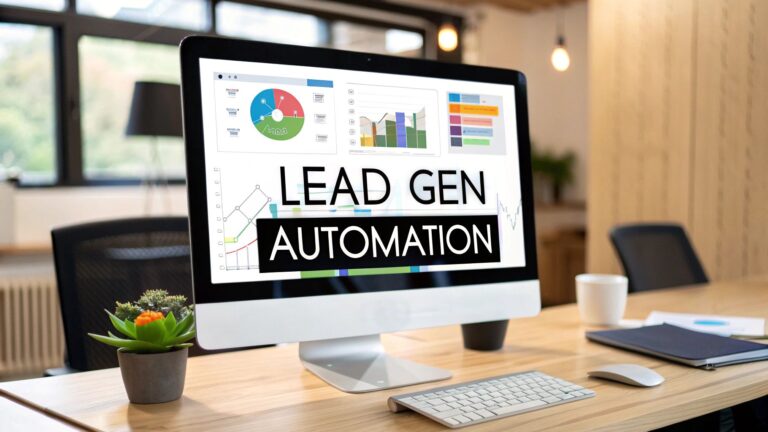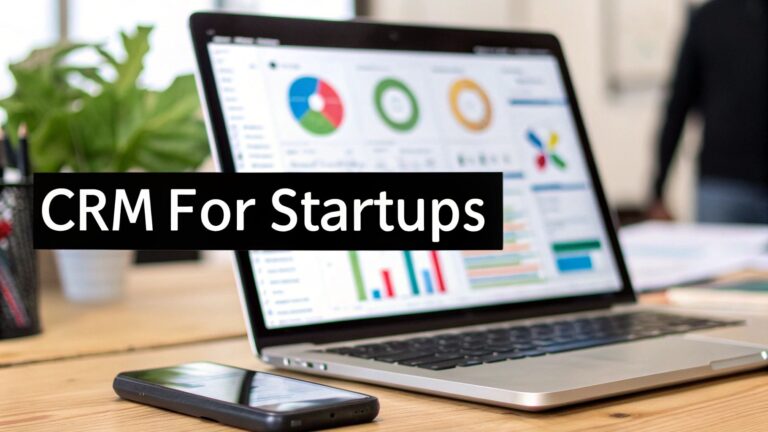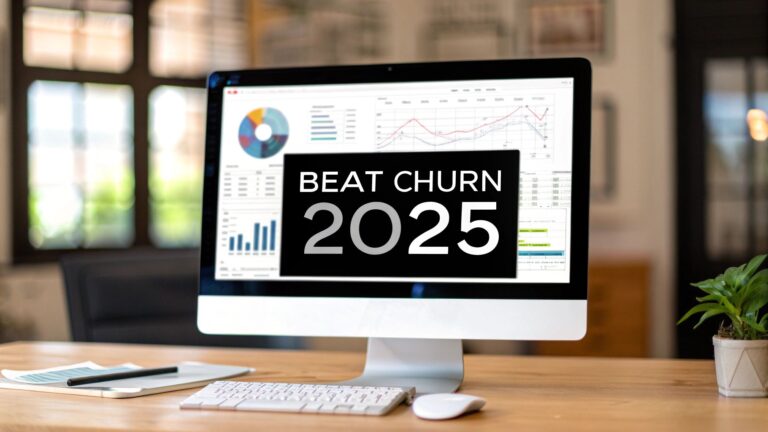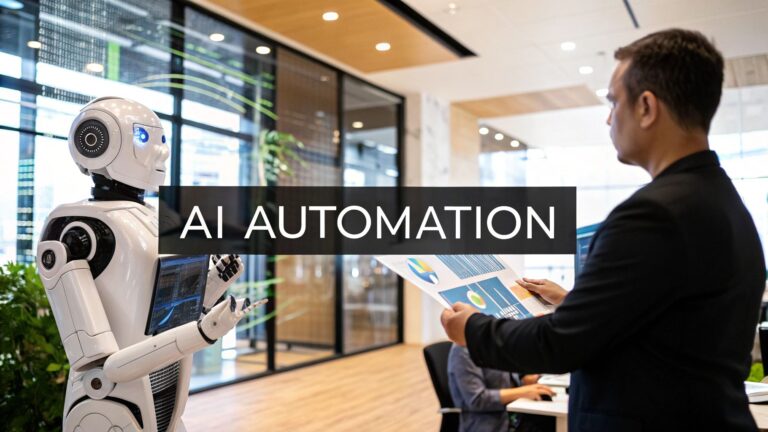How to Build Sales Funnels That Convert
Building a sales funnel isn't just a marketing task; it's a strategic system for guiding someone from a curious stranger to a loyal customer. It boils down to a few key things: deeply understanding who you're selling to, mapping out their journey, creating content that speaks to them at each step, and then using smart automation to move them along.
Your Blueprint for a High-Converting Sales Funnel
Before you even think about AI tools or complex automation sequences, we need to nail down the blueprint. This is the architectural plan for your entire sales engine. Skipping this step is like trying to build a house without a foundation—your efforts will feel random, and you'll end up wasting a ton of time and money.
The whole point of a sales funnel is to visualize the path a potential customer takes. It starts broad at the top, capturing a wide audience, and gradually narrows as people move closer to making a purchase. This structure is your roadmap, showing you exactly where someone is in their buying process so you can deliver the right message at the right moment.
The Foundation: Your Ideal Customer Profile
Let's get one thing straight: if you try to build a funnel for "everyone," you'll end up building it for no one. Generic messaging falls flat. That’s why the absolute, non-negotiable first step is defining your Ideal Customer Profile (ICP).
An ICP is a hyper-specific description of the perfect company you’re built to serve. It goes way beyond basic demographics and gets into the nitty-gritty:
- Firmographics: What industry are they in? How big is the company? What's their annual revenue? Where are they located?
- Pain Points: What specific, nagging problems keep them up at night? What challenges does your solution directly solve for them?
- Goals: What does success look like for them? What are they actively trying to achieve in their business?
- Watering Holes: Where do they hang out online? Are they active in certain LinkedIn groups, reading specific industry publications, or participating in niche forums?
A crystal-clear ICP is your North Star. It stops you from chasing the wrong leads and ensures every dollar you spend on marketing is aimed at attracting people who are a genuinely great fit for your product.
Demystifying the AIDA Model
One of the most enduring frameworks for understanding this customer journey is the AIDA model. It’s been around forever for a reason: it provides a simple, powerful structure for mapping out the stages of your funnel. It's all about moving a prospect through Awareness, Interest, Desire, and finally, Action.
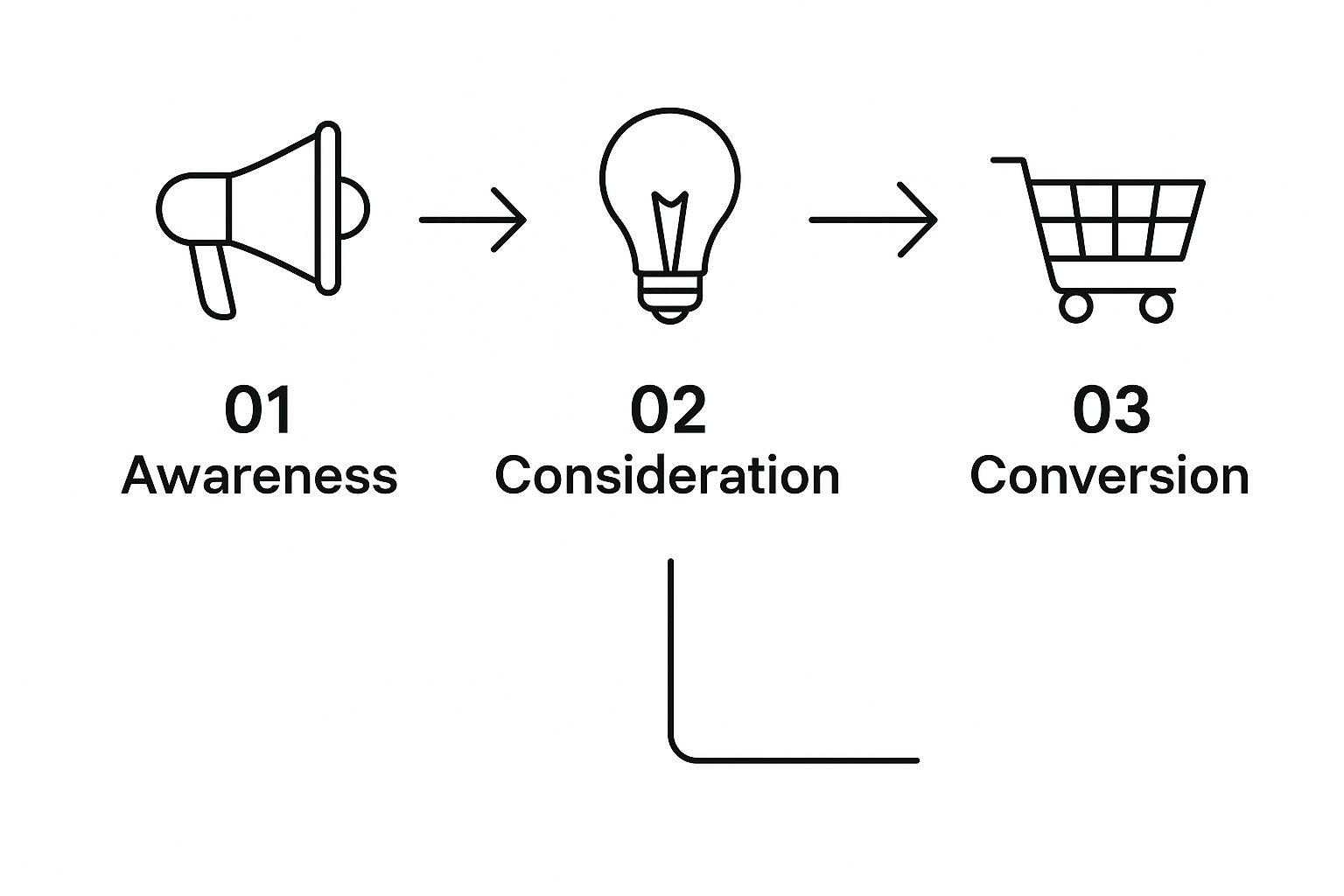
This model makes it clear that the journey is a progression. You can't just jump to the end. Your marketing and sales activities have to be perfectly aligned with each phase to have any real impact. Let's break down what each stage looks like in a modern B2B/SaaS context.
Here's a quick reference table that breaks down the AIDA model into actionable components for your funnel strategy.
| Funnel Stage | Primary Objective | Common Tactics & Channels | Key Metrics (KPIs) |
|---|---|---|---|
| Awareness | Attract attention & educate on a problem. | Blog posts, SEO, social media, podcasts, PR, infographics. | Website traffic, social reach, keyword rankings, impressions. |
| Interest | Nurture curiosity & position your solution. | Webinars, case studies, white papers, lead magnets, email drips. | Lead magnet downloads, email open/click rates, time on page. |
| Desire | Build trust & prove your value proposition. | Demos, free trials, customer testimonials, detailed feature pages. | Demo requests, trial sign-ups, sales-qualified leads (SQLs). |
| Action | Convert the lead into a paying customer. | Pricing pages, checkout flows, consultation calls, special offers. | Conversion rate, customer acquisition cost (CAC), deal size. |
By tracking these specific KPIs at each stage, you can pinpoint exactly where your funnel is leaking and focus your optimization efforts where they'll make the biggest difference.
A classic mistake I see founders make all the time is pushing for the sale way too early. Someone in the Awareness stage doesn't care about your demo; they're looking for an educational blog post that helps them understand their problem. Matching your offer to their stage is crucial for building trust and momentum.
Thinking about your funnel as a series of micro-conversions, rather than one big sale, is a game-changer. The global average sales funnel conversion rate hovers at a meager 2.35%, but the top-performing companies are hitting rates above 11.45%. That massive gap isn't luck—it's the direct result of strategic optimization, something that a surprising 34% of companies admit they rarely practice. You can discover more insights about funnel conversion on amraandelma.com.
Mapping the Customer Journey from Lead to Loyalty
A powerful sales funnel is built on empathy, not just assumptions. Sure, knowing the classic AIDA model gives you a decent framework, but the real magic happens when you get granular. We need to move beyond abstract stages and map every single touchpoint a potential customer has with your brand. This isn't about what you want them to do; it's about deeply understanding what they need to do next.
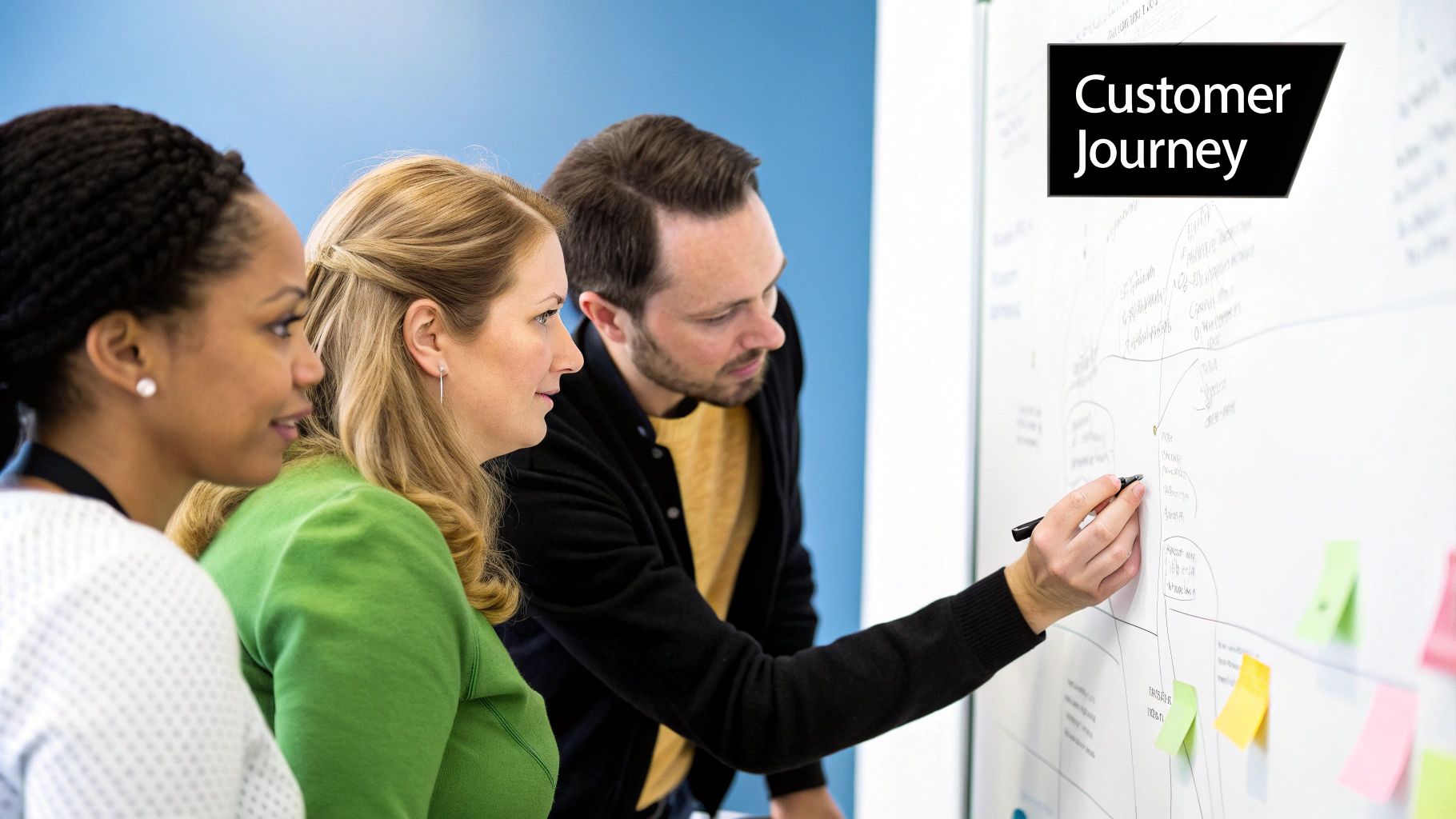
The goal here is to create a journey map that feels authentic and genuinely helpful, not like a forced march toward a sale. To do this, you have to blend two very different types of insight: the cold, hard data from your analytics and the rich, qualitative gold you can only get from real customer conversations. One tells you what is happening, and the other tells you why.
Blending Data with Human Stories
Let's start with the quantitative stuff. Dive into tools like Google Analytics and look at the paths people take through your site. Where are they coming from? Which pages do they linger on? And most importantly, where are they bailing? This data is fantastic at highlighting friction points you might not even know exist.
I saw this firsthand with a SaaS client who had a massive drop-off on their pricing page. The data screamed "problem," but it didn't whisper the cause. Naturally, they assumed the price was too high.
But then they did the qualitative work. They hopped on calls with recent sign-ups and, even better, with prospects who had abandoned the process. It turned out the price wasn't the issue at all—it was the confusing language. Prospects couldn't figure out which tier was right for them, got frustrated, and left. After they simplified the feature descriptions, demo requests shot up by 25%. They didn't have to touch their pricing.
This is a perfect example of why you can't just lean on numbers. Data shows you the symptom, but talking to your customers reveals the cure. Your funnel has to be built on a foundation of genuine customer understanding.
Aligning Content to Funnel Stages
Once you have a clearer picture of your customer’s questions and pain points at each step, you can start strategically aligning your content to meet them there. This is where the classic Top of Funnel (ToFu), Middle of Funnel (MoFu), and Bottom of Funnel (BoFu) model becomes incredibly practical.
- ToFu (Awareness): At this point, your prospects know they have a problem, but they don't know about you or your solution yet. Your content here should educate, not sell. Think insightful blog posts, original research reports, and helpful social media content that speaks directly to their core challenges.
- MoFu (Consideration): Okay, now they’re actively looking at solutions. This is your chance to introduce your product as a top contender. Case studies, webinars, and detailed "how-to" guides are perfect for building trust and showing off your expertise.
- BoFu (Decision): They're ready to pull the trigger. Your content now needs to make it an easy "yes." This is the time for personalized demos, free trials, and crystal-clear pricing pages that eliminate any last-minute hesitation.
By creating this seamless flow of information, you build momentum and trust with every single interaction. And to truly map the journey from a curious lead to a loyal advocate, it's worth exploring how comprehensive omnichannel customer service strategies can keep customers engaged long after the sale.
Identifying Bottlenecks with Stage-by-Stage Metrics
A key part of mapping this journey is knowing what "good" actually looks like at each handoff. In the B2B world, some common benchmarks suggest that roughly 25-35% of raw leads become Marketing Qualified Leads (MQLs), and of those, only about 13-26% convert into Sales Qualified Leads (SQLs).
Tracking your own stage-by-stage conversion rates is critical for spotting where your funnel is leaking. For example, if you're great at turning visitors into leads but those leads never become MQLs, you probably need to beef up your MoFu content.
To really dial this in, marketing and sales need a shared, crystal-clear definition of a "qualified" lead. This is where implementing https://makeautomation.co/lead-scoring-best-practices/ becomes a game-changer. It helps automate the qualification process, ensures everyone is on the same page, and turns your journey map from a simple diagram into a predictable revenue engine.
Choosing Your Tech Stack: The Engine Behind Your Sales Funnel
Your sales funnel isn't just a drawing on a whiteboard; it’s a living system powered by technology. The right tech stack is the central nervous system of your sales operation, making sure data flows where it needs to and that tedious, repetitive tasks just happen on their own. Without a solid stack, even the most brilliant funnel strategy will collapse under the weight of manual work.
Let’s be honest, picking your tools can feel like a nightmare. The market is flooded with options, and every single one promises to be the magic bullet. The secret isn't finding one "perfect" tool. It's about building an interconnected system where each piece of software is great at its job and talks to the others without a hitch.
The Foundation: Your CRM
Everything starts with a solid Customer Relationship Management (CRM) platform. This is your single source of truth for every single prospect and customer. Think of it as the brain of your funnel.
A good CRM, like HubSpot or Salesforce, tracks every interaction—every email opened, every link clicked, every page they visited on your site. This gives your sales team a complete picture of a lead's journey before they even think about picking up the phone.
Core Tools for Every Stage
Once your CRM is in place, you’ll need a few other key players to manage the different stages of the customer journey. The goal here is a seamless experience for your leads and a hyper-efficient workflow for your team.
Here are the non-negotiables:
- Landing Page Builders: You need tools like Unbounce or Leadpages for one simple reason: they are built to convert. They let you spin up and A/B test dedicated pages for your campaigns in minutes, not days. You don't need a developer, which is a massive win for optimizing the top of your funnel quickly.
- Email Automation Platforms: This is where the real nurturing begins. Platforms like ActiveCampaign or Mailchimp let you build out sophisticated email sequences that trigger based on what a user does. This ensures your leads get the right message at the right time, gently guiding them toward making a decision.
- Analytics and Heatmapping Tools: You can't fix what you can't see. Google Analytics is fantastic for the "what"—it tells you how many people visited, where they came from, and which pages they viewed. But tools like Hotjar give you the "why," showing you exactly where people are clicking, how far they scroll, and where they get stuck.
The real magic happens when these tools talk to each other. Imagine this: a new lead fills out a form on your Unbounce landing page. That action automatically adds them to an ActiveCampaign nurture sequence and creates a new contact record in HubSpot, complete with their source. That's a true automation machine, working for you 24/7.
Essential Sales Funnel Tool Comparison
Navigating the sea of software can be tricky. This table breaks down some of the top contenders to help you see what might be the best fit for your business.
| Tool Category | Example Tools | Best For | Key Features |
|---|---|---|---|
| CRM | HubSpot, Salesforce, Pipedrive | Startups to enterprise | Lead scoring, pipeline management, contact history, reporting dashboards |
| Landing Pages | Unbounce, Leadpages, Instapage | Marketers focused on conversion | Drag-and-drop editor, A/B testing, dynamic text replacement, integrations |
| Email Automation | ActiveCampaign, Mailchimp, ConvertKit | Businesses needing targeted nurturing | Visual automation builder, segmentation, behavior-based triggers, reporting |
Each of these tools is powerful on its own, but their true value is unlocked when they are integrated into a cohesive stack that automates the entire customer journey from first touch to final sale.
The Game-Changer: Layering in AI
Today, just having basic automation isn't enough. Artificial intelligence has moved from a buzzword to a practical tool that gives smart founders a serious leg up. AI can personalize at scale, predict who's ready to buy, and help your team focus their energy where it counts.
I once worked with a B2B SaaS company that was completely swamped with leads. Their sales reps were burning hours chasing prospects who were just kicking tires. We brought in an AI-powered lead scoring model that automatically ranked every new lead. The impact was immediate. The team started focusing only on the top 20% of leads and, in one quarter, boosted their close rate by a staggering 40%.
That’s what AI can do for you. It replaces guesswork with data-driven precision.
Here are a few other ways AI is shaking things up:
- AI Chatbots: We're not talking about those clunky, annoying bots from a few years ago. Modern chatbots can qualify leads on your website, book demos straight into a salesperson's calendar, and hand off complex questions to the right human—all without any manual intervention.
- Predictive Personalization: Imagine your website changing in real-time to match a visitor's industry or a problem they're trying to solve. AI can analyze behavior and instantly swap out headlines or calls-to-action to be more relevant, dramatically increasing the chances of conversion.
- Automated Lead Generation: AI is a beast when it comes to filling the top of your funnel. To see how this works in practice, you can explore our guide on how to automate lead generation for more actionable strategies.
Building your tech stack is a critical step. Start with the core trio—CRM, landing pages, and email automation—and make sure they play nicely together. Then, start layering in smart AI tools to take your funnel from good to unstoppable.
Crafting Compelling Content for Each Funnel Stage
If your tech stack is the engine, then your content is the fuel that makes the whole thing go. Without the right content, prospects stall out, leads go cold, and your entire system grinds to a halt.
The secret is to stop thinking about "content" as one generic blob. Instead, you need to meticulously map specific assets to the precise questions your ideal customer has at each stage of their journey.
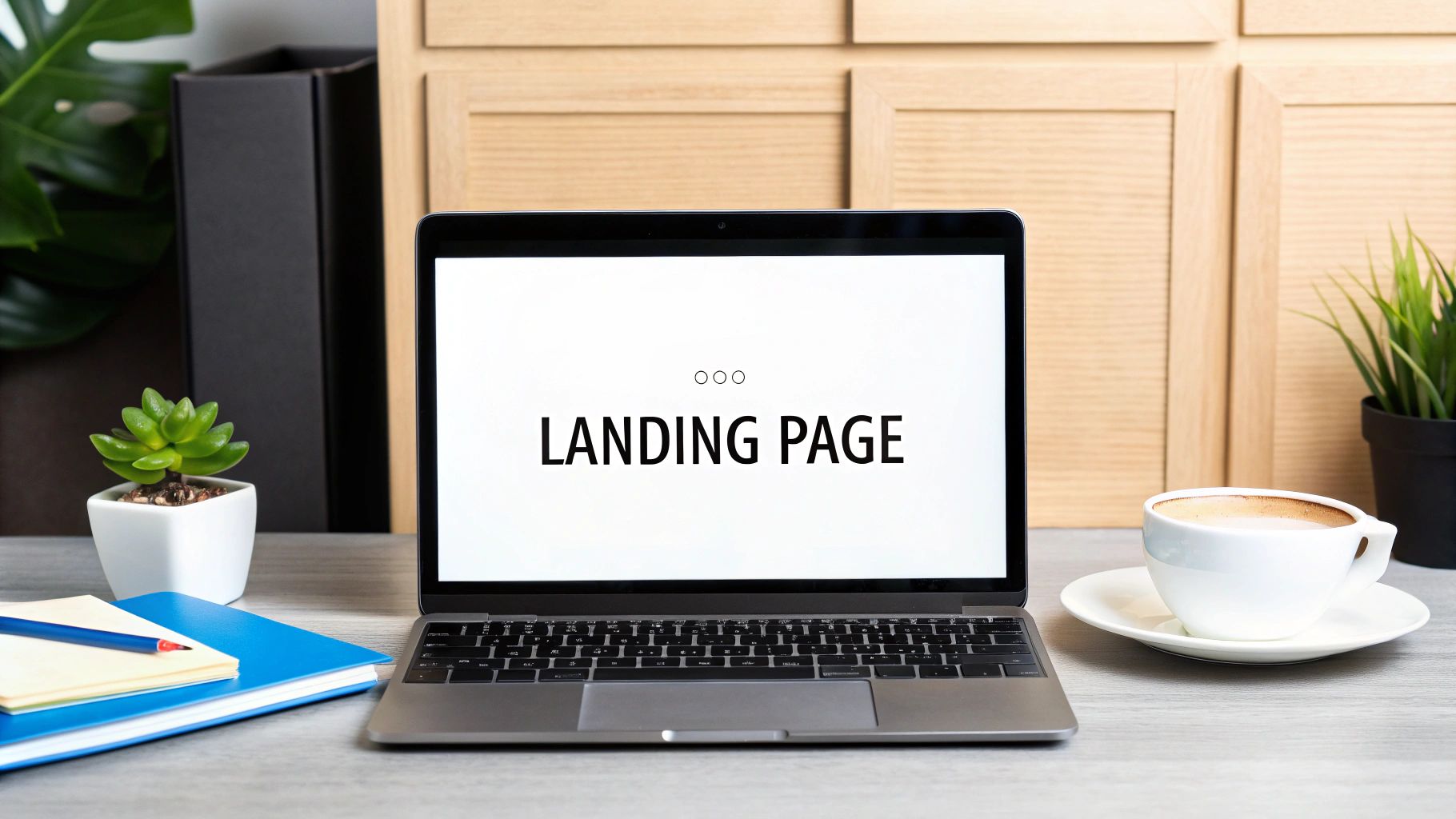
Your goal isn't just to create a bunch of articles and videos; it's to architect a seamless conversation. Each piece should answer a prospect's immediate question and then naturally guide them to the next one, pulling them deeper into your world. This approach turns a random collection of assets into a strategic pathway to a signed deal.
Fuelling the Top of Your Funnel
At the very top, in the Awareness stage, prospects don't want a sales pitch. They’re usually just "problem-aware," not "solution-aware." They're hunting around on Google for answers, insights, and education related to a pain point that's just started bugging them. Your content has to meet them right there, with zero strings attached.
The mission is simple: educate and attract. Your content needs to be genuinely helpful, insightful, and easy to discover.
These are the workhorses for the top of your funnel:
- Actionable Blog Posts: Forget generic advice. You need to write in-depth articles that solve a specific, nagging problem for your ideal customer profile. Think "How to Reduce Churn in a Usage-Based SaaS" instead of just "What is SaaS Churn?"
- Data-Rich Infographics: People are wired to love visual, shareable data. If you have original research or can package industry stats in a compelling way, infographics are gold for grabbing attention and earning backlinks.
- Insightful Social Media Updates: Share quick tips, ask thought-provoking questions, or post snippets from your blog content on platforms like LinkedIn where your audience actually hangs out.
At this stage, your call to action shouldn't be "Book a Demo." That's way too soon. Instead, gently suggest they read another related article, download a helpful checklist, or subscribe to your newsletter. You’re building trust, not forcing a sale.
Building Trust in the Middle Funnel
Once a prospect engages with that initial content, they slide into the Interest and Desire stages. Now they know who you are and are starting to see you as a credible source. Your content’s job shifts from broad education to building a specific case for a solution like yours.
Here, the objective is to build authority and demonstrate value. You have to show them not just what to do, but how your product is the key to getting it done.
Effective middle-funnel content includes:
- In-Depth Webinars: Host a live session that goes deep on a complex topic. This showcases your expertise and gives prospects a fantastic opportunity to ask questions directly.
- Compelling Case Studies: Nothing builds trust faster than social proof. A detailed case study walking through a real customer's problem, your solution, and the impressive results is one of the most powerful assets you can possibly create.
- Comprehensive White Papers or Reports: For a serious B2B audience, a well-researched report or white paper is an incredible lead magnet that cements your status as a thought leader.
I once saw a B2B tech company use a single, data-rich industry report as their main top-of-funnel offer. They nurtured everyone who downloaded it with a targeted email sequence of case studies and webinar invites. That simple strategy led to a 30% increase in qualified demo requests in just one quarter.
Driving Action at the Bottom Funnel
Finally, at the Action stage, your prospect is ready to pull the trigger. They’re comparing you against competitors and looking for that one clear reason to choose you. Your content now needs to remove every last bit of friction and make saying "yes" the easiest, most logical next step.
Your objective is to convert and close. The content must be direct, value-driven, and focused on that final conversion.
The best bottom-of-funnel offers are:
- Personalized Demos: Offer a one-on-one walkthrough that's specifically tailored to the prospect's use case and pain points.
- Free Trials or Pilots: Let them experience the value of your product firsthand. A well-designed trial can be your most effective salesperson.
- Clear Pricing Pages and FAQs: Kill any last-minute questions or uncertainty. Make your pricing, implementation process, and support options crystal clear.
By strategically aligning your content with each funnel stage, you create a powerful, persuasive journey that guides prospects from a vague awareness of a problem to a confident purchase decision.
Optimizing Your Funnel for Maximum Conversion
So, you've launched your sales funnel. Pop the champagne? Not quite. Getting your funnel live is just the starting gun—the real race is won through constant, intelligent tweaking. The biggest gains don't come from the initial setup; they come from a relentless focus on data-driven optimization.
This is where you graduate from a "set it and forget it" approach to a cycle of continuous improvement. Your goal is to transform that funnel from a hopeful experiment into a predictable, revenue-generating machine.
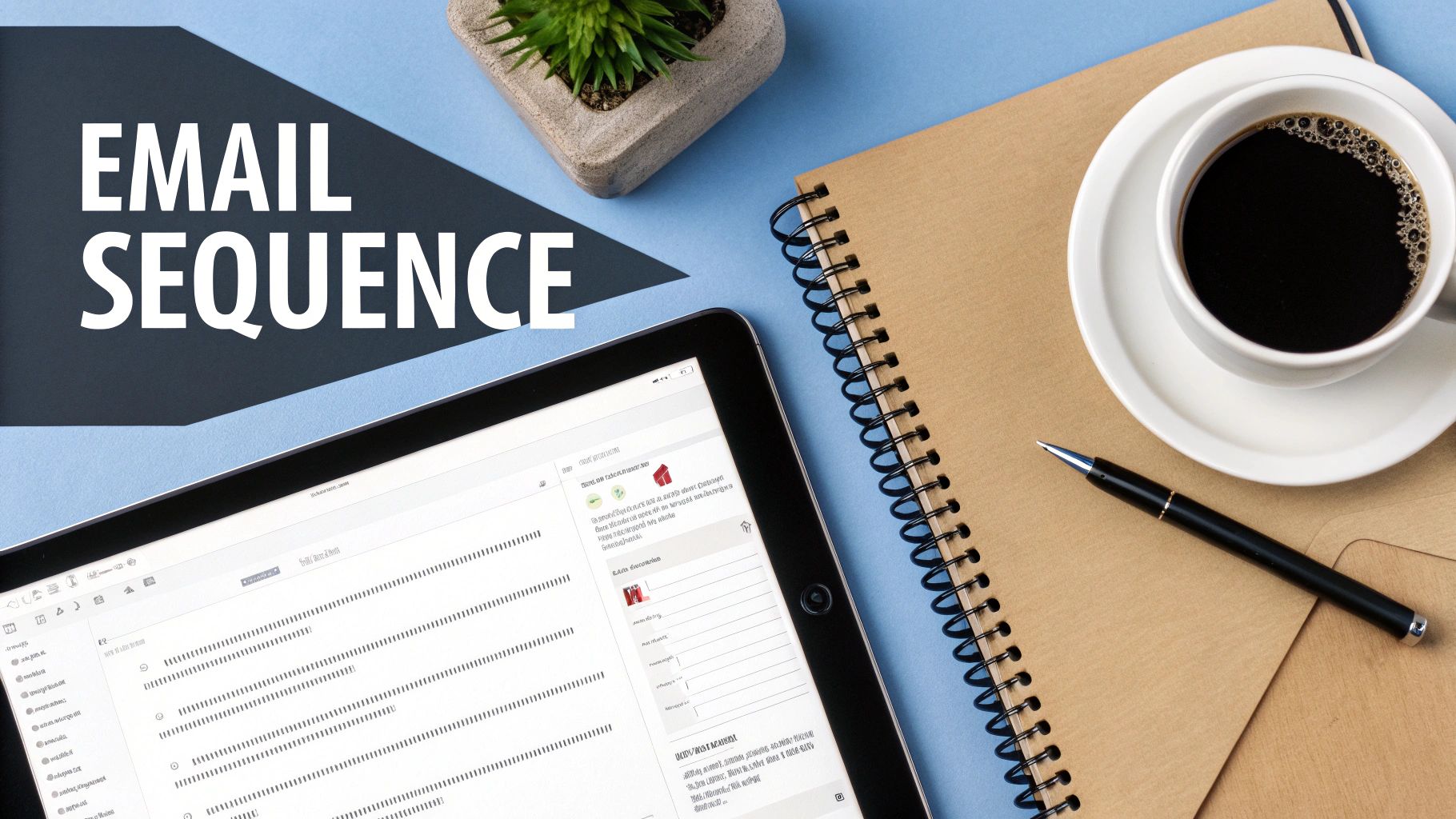
This isn’t about guesswork or following your gut. It's about letting the numbers and real user feedback guide your every move. Each adjustment should be a calculated decision aimed at improving a specific metric, whether that's getting more sign-ups on a landing page or boosting demo requests.
Making Data-Driven Decisions with A/B Testing
The bedrock of funnel optimization is A/B testing. The concept is simple but powerful: you create two versions of a single element (like a landing page or an email subject line), show each version to a different slice of your audience, and see which one performs better.
This methodical approach takes ego and assumptions completely out of the picture. Instead of your team debating whether a blue or green button will get more clicks, you just test it and let the data give you the definitive answer.
You can A/B test just about anything, but your time is valuable. Focus on the elements that can swing the needle the most:
- Headlines: Try different angles. Does a headline that agitates a major pain point outperform one that highlights a key benefit?
- Calls-to-Action (CTAs): Play with the button text, color, and placement. I've seen a simple change from "Learn More" to "Get Your Free Demo" double conversion rates.
- Page Layouts: Test different arrangements of testimonials, feature lists, and forms. Sometimes moving a customer logo above the fold can make all the difference.
- Offer Framing: How you present your lead magnet or trial matters. Is a "7-Day Free Trial" more compelling than a "Risk-Free Pilot"? Test it and find out.
A key mistake I see founders make is calling a test too early. Don't declare a winner after just 50 visitors. You need to reach statistical significance to ensure your results are reliable, not just a random fluke. Use a sample size calculator to know when you have enough data to make a confident call.
Understanding the Why Behind the What
A/B testing is brilliant at telling you what works better, but it often leaves you guessing why. To get the full picture, you need to layer in qualitative tools that show you how people are actually experiencing your funnel. This is where you connect the cold, hard numbers with real human behavior.
Tools like Google Analytics are fantastic for tracking the user journey and spotting drop-off points. If you see that 70% of visitors bail on your pricing page, you’ve just found a massive leak in your funnel.
But that data alone doesn't tell you how to fix it. That's where a tool like Hotjar comes in. Heatmaps visually show you where people are clicking, how they move their mouse, and how far they scroll down a page. You might discover they're rage-clicking on an image that isn't a link, or they're completely missing your main CTA because it's buried "below the fold." These are the golden nuggets of insight that quantitative data can't give you.
Prioritizing Your Best Leads
Let's be honest: not all leads are created equal. A massive part of funnel optimization is making sure your sales team spends their precious time on prospects who are actually ready to talk business. This is exactly what lead scoring is for.
Lead scoring is simply a system for assigning points to leads based on who they are and what they do. It might look something like this:
- Lead from a target industry? +10 points.
- Downloaded a bottom-of-funnel case study? +15 points.
- Visited the pricing page twice in one week? +5 points.
Once a lead hits a certain score—say, 50 points—they're automatically marked as a Sales Qualified Lead (SQL) and routed straight to your sales team's calendar. This one system prevents reps from wasting hours on lukewarm prospects and lets them laser-focus on closing deals. For a deeper look, check out these advanced sales funnel optimization strategies.
Ultimately, sending warmer, better-qualified leads to your sales team has a direct impact on your bottom line. Average sales call conversion rates—a critical metric—hover between 13% and 25%. That number is massively influenced by lead quality. For instance, referrals can convert at an incredible 25.56%, while large enterprise deals often close at a much lower rate. The better the lead, the higher the close rate. It's that simple. Discover more insights about sales call conversion rates from Focus Digital.
Common Questions I Hear About Building Sales Funnels
Even with the best roadmap, building your first sales funnel can feel a bit daunting. Let's walk through some of the questions that pop up time and time again when I'm working with founders. My goal is to give you clear, no-fluff answers so you can move forward with confidence.
How Long Does This Actually Take?
Honestly, the timeline for building a sales funnel is all over the map—it really hinges on how complex you make it.
You could get a simple, lean funnel up and running in just a few days. I'm talking a solid landing page, a basic email sequence, and a thank-you page. If you have your tools picked out and your messaging dialed in, this is a fantastic way to start collecting real data, fast.
On the other hand, a more sophisticated B2B funnel can be a bigger project. If you're planning on deep CRM integration, multiple content layers like webinars and detailed case studies, and a smart lead scoring system, you're realistically looking at several weeks of planning, building, and testing.
My advice? Always start with a Minimum Viable Funnel (MVF). Get a basic version live, see what people actually do, and then improve it based on that feedback. You'll learn more from one week of real-world data than you will from three weeks of whiteboarding the "perfect" funnel that doesn't exist yet.
What's the Biggest Mistake People Make?
This one's easy, and I see it all the time. The single most expensive mistake is building a funnel based on what you think your customers want, instead of what you know they want.
So many businesses get caught up in the cool tech and fancy automation tactics that they completely skip the foundational customer research. They end up with generic messaging and offers that just don't land because there's no real human problem behind it.
A funnel that actually converts is built on an almost obsessive understanding of your customer's biggest headaches, their ultimate goals, and the exact questions they're Googling at 2 AM. If you skip this part, you’re just building a beautiful machine to talk to an audience that isn't listening. That's why most funnels fail.
How Do I Know If My Sales Funnel Is Working?
To get a real answer here, you have to look beyond the final sale. The only way to know if your funnel is working is to track the key metrics at each stage. This is how you spot the leaks before they sink the ship.
Instead of just looking at revenue, zoom in on these specific conversion points:
- Visitor-to-Lead Rate: Is your landing page actually compelling enough to get someone to hand over their email? This tells you if your initial hook is working.
- Lead-to-MQL Rate: Are your emails, webinars, or case studies actually good enough to turn a casual lead into someone genuinely interested? This is where nurturing happens.
- MQL-to-SQL Rate: Of those interested leads, how many are actually qualified and ready for a conversation with your sales team?
And don’t forget to track your overall Customer Acquisition Cost (CAC) and the average time it takes to close a deal. For example, if you have a ton of sign-ups but almost no one becomes an MQL, you know your top-of-funnel is great, but your mid-funnel content is falling flat. This granular view is what separates the pros from the people who are just guessing.
Ready to stop guessing and start building an automated system that drives predictable growth? The experts at MakeAutomation specialize in designing and implementing AI-powered sales funnels and automation frameworks that help B2B and SaaS companies scale efficiently. Eliminate manual workflows and accelerate your growth with MakeAutomation today.


